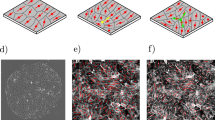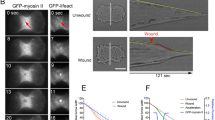Abstract
PREVIOUS papers from this laboratory have demonstrated the production of proliferation-promoting factors (intercellular wound hormones) by cell aggregates subjected to lethal ultra-violet or X-rays1, heteroauxin2, and carbon dioxide3. These factors are evidently produced by living cells as a response to injury, since the maximum production of the hormones precedes the maximum rate of killing3.
This is a preview of subscription content, access via your institution
Access options
Subscribe to this journal
Receive 51 print issues and online access
$199.00 per year
only $3.90 per issue
Buy this article
- Purchase on Springer Link
- Instant access to full article PDF
Prices may be subject to local taxes which are calculated during checkout
Similar content being viewed by others
References
Fardon, Norris, Loofbourow and Ruddy, NATURE, 139, 589 (1937); Sperti, Loofbourow and Dwyer, ibid., 140, 643 (1937); Studies Inst. Divi Thomae, 1, 163 (1937): Fardon, Carroll and Ruddy, ibid., 1, 17 (1937); Loofbourow, Dwyer and Morgan, ibid., 2, 137 (1938).
Loofbourow and Dwyer, Science, 88, 191 (1938); Studies Inst. Divi Thomae, in the press.
Loofbourow and Dwyer, NATURE, 143, 725 (1939).
Cook, Loofbourow and Stimson, 10th Internat. Congress of Chemistry, Rome, May 1938; Loofbourow, Cook and Stimson, NATURE, 142, 573 (1938).
Author information
Authors and Affiliations
Rights and permissions
About this article
Cite this article
LOOFBOUROW, J., COOK, E., DWYER, C. et al. Production of Intercellular Hormones by Mechanical Injury. Nature 144, 553–554 (1939). https://doi.org/10.1038/144553a0
Issue Date:
DOI: https://doi.org/10.1038/144553a0
This article is cited by
-
Wound healing in higher plants
The Botanical Review (1941)
Comments
By submitting a comment you agree to abide by our Terms and Community Guidelines. If you find something abusive or that does not comply with our terms or guidelines please flag it as inappropriate.



